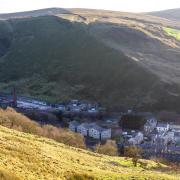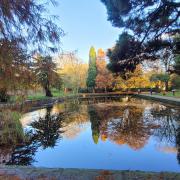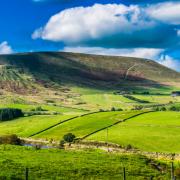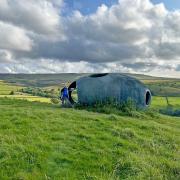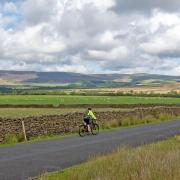Keith Carter squelches through a farm yard on a walk which explores the countryside around Cockerham
Cockerham appears in the Domesday Book as Cocreham, a homestead on the river described as twisted or crooked in the Celtic language.
The River Cocker here is not to be confused with that of the same name further north which has its estuary at Cockermouth, the river that flooded disastrously in 2009 and carried away the bridge and caused a huge amount of damage to the town.
Our River Cocker rises near Quernmore and flows into the Lune Estuary near Glasson Dock. It's not much of a river really and has not much to distinguish it from other channels and streams in this low-lying area.
Cockerham village is notable for the isolated church of St Michael standing in the fields to the south west, quite separate from the village centre.
It's a striking location and an interesting church even if it is kept locked when not in use. The sea seems very near; in fact it was probably covering where the church now stands at one time.
I researched this month's walk on a fine Monday, parking at the Parish Hall from where an access lane goes straight to the church. Walk to the crossroads by the Manor Inn, turn right along the Lancaster road and at the last bungalow take an opening on the right where a sign says Batty Hill Farm.
Don't expect too many way marks this soon on the walk. There are none through the farm but you walk through, past the cattle munching on their silage, and on reaching a fork, keep left to leave the farm behind.
Recent rainfall had alerted me to the likelihood of muddy conditions and I had gaiters on but nothing could have prepared me for the mud in the farm lane. You can try to avoid the worst of it but in places all you can do is wade through - it must have been like this on the Western front in WW1, practically sucking the boots off your feet.
I bet cows love it, and small children who love sloshing through puddles. Just when you are wondering how you are going to escape it you emerge into a field with great relief.
The crop during the summer was maize and only the stalks remain but the farmer had thoughtfully left a broad path across his crop and its trace is still visible cutting across the field at ten o'clock. This brings us to a stile in the far hedge with three steps up and a footbridge over a dike from where we head across a further field to the prominent farm ahead. This is Cock Hall Farm.
We pass through it and take a right turn once past the out buildings, go through a gate and follow a track towards a break in the trees ahead. After two further gates the same track brings us to the Lancaster Canal, or at least the Glasson Dock arm of it, at Third Lock Bridge.
There's something about canals that appeals to those with a tidy mind.
They're so straight and well-maintained, the towpaths cut and the edges dredged. It says a lot for British Waterways for the way they paint the locks and trim back the bushes. This stretch is the link from the main canal to Glasson basin, probably built to bring cargo to the port of Lancaster, an improvement of the horse-drawn transport which used to do it.
There are no locks on the main canal but several on the Glasson Arm and where we meet the canal is shown on the map as Third Lock Bridge. Turn right onto the towpath and walk as far as the next bridge, no.2 and there leave the canal, cross the bridge and take the enclosed lane. Gated in places this lane is not marked as a right of way but it leads to a group of buildings mostly neglected, Holme Farm.
One building has been restored and is called The Stables, no doubt once serving Ellel Grange, the stately pile seen ahead of us. We leave the lane at a footpath on the right through a gateway and descend a field with a copse to our left. At the bottom go through two gates in an overgrown area also with an air of neglect about it.
Through the second gate turn left and cross quite a narrow field to meet the River Cocker crossed by two footbridges - you can cross either. You may have noticed blue waymarks hereabouts on the route of a walk called Breath of Fresh Air. I had not heard of this so looked it up and found that some walkers had organised some routes of their own totalling 22 miles - if you want to know more check out www.breathoffreshair.co.uk Ellel Grange is a religious study centre.
Once across one of the footbridges you notice a hill ahead, an unusual feature in this area even if it is only 35 metres above sea level. Our direction keeps this to our right, climbing gradually at roughly ten o'clock and as you clear the brow, a fence line crosses our path with a stile in it. Cross this and head for another footbridge which can be seen across a field.
The land now climbs and we maintain our previous direction, aiming for a line of pylons marching across the countryside.
On meeting the corner of the field you find a gate with a slurry tank beside it converted into a water trough for the cows. Go through the gate, pass a pond on your right and head for the nearest pylon under which there is a gate. Go through this and make for a restored, red-brick group of buildings, keeping slightly to the left of it.
Through a metal gate we pass along an enclosed green lane and emerge at the access lane to the converted buildings shown on the map as Up Town. Turn left here on the track used by the residents of Up Town which becomes Willey Lane and emerges on the road in Cockerham village.
Turn left then left again at the Manor Inn and inside a few paces we are back at the Parish Hall.
COMPASS POINTS Area of walk: Cockerham Distance: 3½ miles Time to allow: 2 hours Map: OS Explorer 296 Lancaster, Morecambe and Fleetwood Refreshments: None on this walk. The Manor Inn does not open weekday lunchtimes Not suitable for wheelchairs or pushchairs



